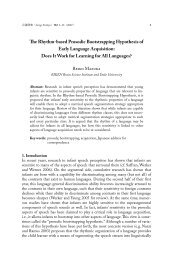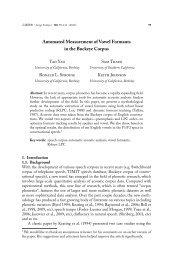第117åæ¥æ¬è§£åå¦ä¼ç·ä¼ã»å ¨å½å¦è¡éä¼ è¬æ¼ããã°ã©ã ã»æé²é PDF ...
第117åæ¥æ¬è§£åå¦ä¼ç·ä¼ã»å ¨å½å¦è¡éä¼ è¬æ¼ããã°ã©ã ã»æé²é PDF ...
第117åæ¥æ¬è§£åå¦ä¼ç·ä¼ã»å ¨å½å¦è¡éä¼ è¬æ¼ããã°ã©ã ã»æé²é PDF ...
You also want an ePaper? Increase the reach of your titles
YUMPU automatically turns print PDFs into web optimized ePapers that Google loves.
60<br />
117 <br />
<br />
GlialAxon Interactions in Health and Disease<br />
Bruce D. TrappDepartment of Neurosciences, Lerner Research Institute, Cleveland Clinic, USA<br />
The interaction between myelin forming cells and axons is one of the best described examples of cellcell<br />
interactions in mammals. Myelin plays multiple roles essential for normal nervous system function. Best<br />
known is the insulation of axons to permit rapid propagation of nerve impulses by saltatory conduction. By<br />
concentrating voltage gated sodium channels at nodal axoplasm myelin also saves energy. To attain similar<br />
conduction speeds of myelinated axons, unmyelinated axons would have to have diameters 100 times larger<br />
than myelinated axons. Myelin, therefore, also conserves space. One of the most clinically relevant functions<br />
of myelin is provide trophic support essential for axonal survival. This function reflects the fact that axons<br />
can be meters away from the neuronal cell body and has to rely on glia support rather than on neuronal gene<br />
transcription to respond to many local changes in environment. Since axonal degeneration is the major cause<br />
of neurological disability in primary diseases of myelin, we have been investigating the mechanisms by which<br />
myelin provides trophic support to axons. The purpose of this presentation is to summarize these studies with<br />
an emphasis on morphological studies of normal and abnormal myelin-axon interactions. Myelin is essential<br />
for long-time axonal survival. This is best illustrated by the primary axonal degeneration that develops in<br />
mice null for the myelin proteins MAG, PLP or CNP. The precise mechanisms by which myelin stabilizes the<br />
axon is poorly understood. Two general features are common to the axonal pathologies that precede axonal<br />
degeneration: the axonal cytoskeleton is abnormal and the pathologies dominate in paranodal regions. We<br />
have compared paranodal axoplasm in myelinated, demyelinated and dysmyelinated axons using time lapse<br />
imaging and 3-dimensional electron microscopy. We detect alterations in transport and distribution of axonal<br />
mitochondria and smooth endoplasmic reticulum following demyelination and dysmyelination. These data<br />
suggest that altered ATP production and calcium homeostasis precede axonal degeneration. In addition the<br />
stability, length and orientation of microtubules which contain increased phospho tau epitopes were detected.<br />
Alterations in microtubules inhibit axonal transport and result in paranodal axonal swellings due to organelle<br />
accumulation. We are also investigating molecular mechanisms responsible for mitochondria fission and fusion<br />
in normal, demyelinated and dysmyelinated axons. These studies are unraveling the cascade of molecular and<br />
morphological changes that eventually result in axonal degeneration so we can identify therapeutic targets that<br />
may delay or stop axonal degeneration in primary diseases of myelin.







